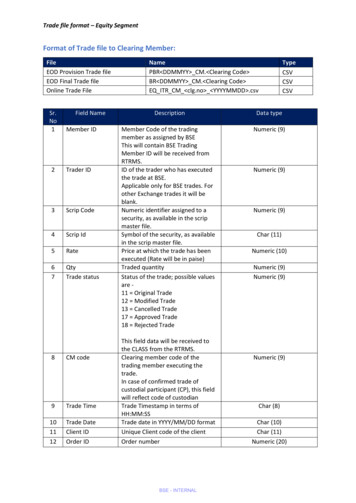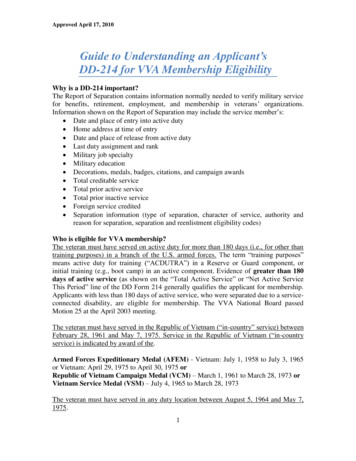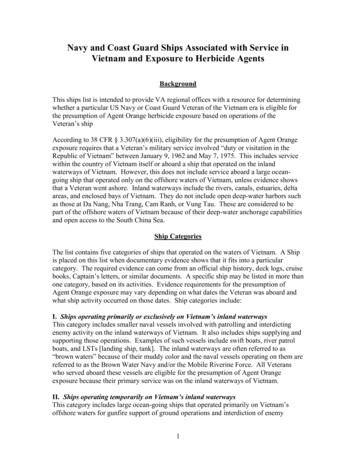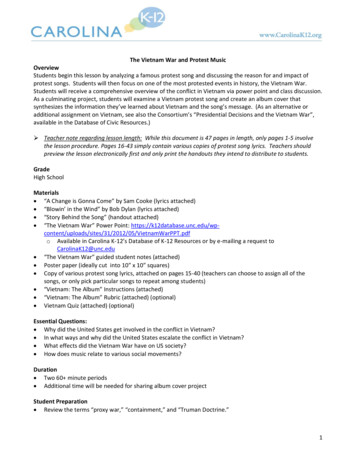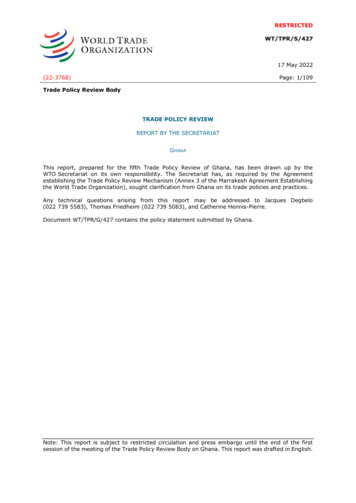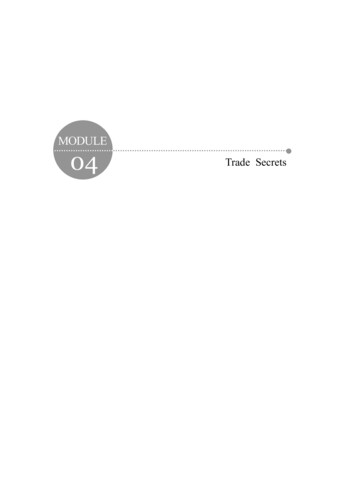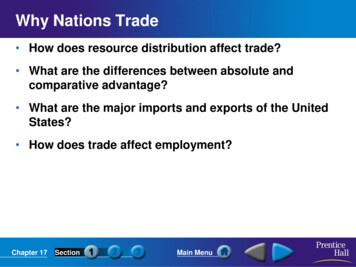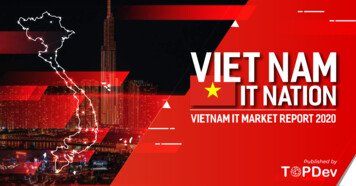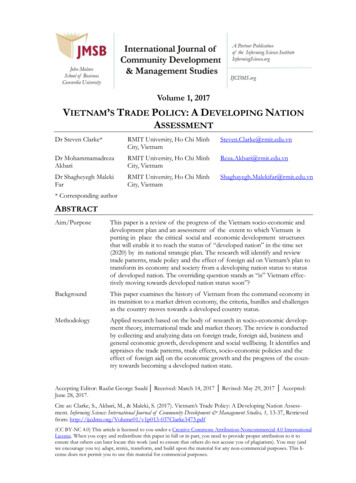
Transcription
Volume 1, 2017VIETNAM’S TRADE POLICY: A DEVELOPING NATIONASSESSMENTDr Steven Clarke*RMIT University, Ho Chi MinhCity, VietnamSteven.Clarke@rmit.edu.vnDr MohammamadrezaAkbariRMIT University, Ho Chi MinhCity, VietnamReza.Akbari@rmit.edu.vnDr Shagheyegh MalekiFarRMIT University, Ho Chi MinhCity, VietnamShaghayegh.Malekifar@rmit.edu.vn* Corresponding authorABSTRACTAim/PurposeThis paper is a review of the progress of the Vietnam socio-economic anddevelopment plan and an assessment of the extent to which Vietnam isputting in place the critical social and economic development structuresthat will enable it to reach the status of “developed nation” in the time set(2020) by its national strategic plan. The research will identify and reviewtrade patterns, trade policy and the effect of foreign aid on Vietnam’s plan totransform its economy and society from a developing nation status to statusof developed nation. The overriding question stands as “is” Vietnam effectively moving towards developed nation status soon”?BackgroundThis paper examines the history of Vietnam from the command economy inits transition to a market driven economy, the criteria, hurdles and challengesas the country moves towards a developed country status.MethodologyApplied research based on the body of research in socio-economic development theory, international trade and market theory. The review is conductedby collecting and analyzing data on foreign trade, foreign aid, business andgeneral economic growth, development and social wellbeing. It identifies andappraises the trade patterns, trade effects, socio-economic policies and theeffect of foreign aid] on the economic growth and the progress of the country towards becoming a developed nation state.Accepting Editor: Raafat George Saadé Received: March 14, 2017 Revised: May 29, 2017 Accepted:June 28, 2017.Cite as: Clarke, S., Akbari, M., & Maleki, S. (2017). Vietnam’s Trade Policy: A Developing Nation Assessment. Informing Science: International Journal of Community Development & Management Studies, 1, 13-37, Retrievedfrom: f(CC BY-NC 4.0) This article is licensed to you under a Creative Commons Attribution-Noncommercial 4.0 InternationalLicense. When you copy and redistribute this paper in full or in part, you need to provide proper attribution to it toensure that others can later locate this work (and to ensure that others do not accuse you of plagiarism). You may (andwe encourage you to) adapt, remix, transform, and build upon the material for any non-commercial purposes. This license does not permit you to use this material for commercial purposes.
Vietnam Trade PolicyContributionThe findings will assist academic, business and government researchers, policy and decision makers engaged developing Vietnam’s trade policies andstrategic plan for its it future growth and economic progress towards a developed nation status. The paper will also provide additional insight into thebusiness and market structure and] environment in Vietnam and the role itplays aiding its growth and development.FindingsVietnam has experienced significant progress to date based on conventionaldeveloped nation criteria. However, there is an ongoing need for continuedassertive governmental application of geo-economic and geopolitical policiesfocusing on sustainable, comprehensive, and vital social, cultural and economic growth.Recommendations Specific policies and strategies for government and business reforms in Vifor Practitionersetnam must focus on,1. Replacing the projected benefits in growth utilizing accomplishmentsto date from negotiations and strategic development of the TPP, inspite of current delays or withdrawal.2. Continuing use of US financial aid and ODA sources to enhanceHDI and support Vietnam’s commercial and social opportunities3. Continued industrial zone development4. Continued human labor improvements5. Continued export expansion programs6. Continued close working relationship with the WTO7. Continued development strategies including SEDS, SEDPs, andFTAsRecommendationfor ResearchersResearchers, when collecting economic and social data, need to [adhere toWorld Trade Standards data collection, measurement, classification, andestimation of trading data: for example,] precisely define, and determinethe validity, accuracy, expected bias and relevant statistics and classificationmethods used by government agencies and international organizations.Impact on SocietyVietnam’s drive towards developed nation status will enhance the quality oflife for a greater number of its citizens.Future ResearchFuture researchers ought to focus on specific elements of HDI and forms offoreign aid support for long-term economic and social development, andenhancing governmental reform of its dynamic and strategic developmentpotential.KeywordsDeveloping nation, trade, terms, patterns, preferences, development and policy, foreign aid, import substitution, and export-led growthINTRODUCTIONKofi Annan, former Secretary of the UN, defined a developed country as: “A developed country isone that allows all its citizens to enjoy a free and healthy life in a safe environment” (Annan, 2000,Para. 10). Two thirds of The World Trade Organization’s (WTO) 150 affiliates are designated asundeveloped nations, including Vietnam. The International Monetary Fund (IMF) acknowledgesthat general economic data and criteria for classifying countries as advanced versus emerging market are not precise. The United Nations labels 159 nations as having developing status. TheWorld Bank, while it maintains a list of least developed nations (Table A1, Appendix) has chosento eliminate the terms “developed” or “developing countries”. Moreover, designations or classifications for “developed” and “developing nations” further vary, based on the additional organiza-14
Clarke, Akbari, Maleki Fartions providing the review, statistically created for evaluating and classifying the development stageof nations. Additional designations include less industrialized, lower per capita income, lower levels of modern advancements, and lesser utilization of resources.Vietnam has enjoyed a geo-economic transformation since the launch of the “Doi Moi” (reform)policy in 1986, reflected by an average near 7% growth in GDP over the last couple of decades,second only to China. Nevertheless, continued growth and competitiveness requires ongoing attention to intensified government transparency and openness, amended regulatory policy and tradeaffairs, and support from developed countries. “Vietnam, a one-party Communist state, has one ofsoutheast Asia’s fastest growing economies and has set its sights on becoming a developed nationby 2020” (BBC, 2016, Para 1).The transition to a market oriented economic model can be characterized by four sub-periods outlined as follows:1. 1986 through 1994 - The period of “entrepreneurial policy-makers”2. 1995 through 1999 - The period of monetary integration and conversion to a marketdriven economy3. 2000 through 2006 – The period of economic affluence and emerging cultural values4. 2007 to present – The period of globalization and attitudes toward global geopoliticaland geo-economics. (Voung, 2014).Vietnam authorities have adopted a socio-economic development plan based on the political philosophy of “scientific socialism” to promote and defend the country's development and nationalinterest. The success of socio-economic strategy has reaffirmed the Government’s commitment toa gradual structural transformation of the society and modernized the economy using socialisteconomic concepts; but based on competitive export driven industries within a more open marketdriven economy.These objectives were to be partially implemented by participating in the 2015 Trans-Pacific Partnership (TPP) free trade agreement engaging 12-Nations. The development strategy consisted ofthe ten-year Socio-Economic Development Strategy (SEDS), and the five-year Socio-EconomicDevelopment Plans (SEDPs) at national, sectoral, and provincial levels.The following is an excerpt from a Government release on the Vietnam’s Socio-economic Development Strategy for the Period of 2011-2020: It claims that“Up to 2010, the average GDP per capita has reached US 1,168. The economic structurehas been shifted in a positive way. The socialist oriented market economy regulation hasbeen continually improved. Important achievements have been obtained in many aspectsof cultural and social fields. People’s physical and spiritual lives have been significantly improved; freedom in belief and religion has been respected; gender equality has seen manyprogresses; democracy in the society has been continually expanded. The work in foreignaffairs and international integration has been widely, deeply and effectively implemented;national defense and security have been strongly maintained, which creates a peaceful andstable environment as well as increases more resources for national development” (Vietnam Government, n.d.).Apart from the proposed TPP free trade agreement, Vietnam is a member404 of ASEAN, and theKorean/Chile/Japan/India/Australia/New Zealand free trade and economic partnership agreements, (FTAs). In addition, Vietnam has instituted diplomatic associations with more than 170countries around the world, strategic alliances with 12 essential markets, including emerging markets; and industrialized countries such as China, Russia, Japan, England, France, India, North Korea, Italy, Germany, Indonesia, Thailand, and Malaysia (Vuong, 2014). As of 2014, Vietnam became the 28th largest export nation in the world, and the 93th greatest multifaceted economy as per15
Vietnam Trade Policythe Economic Complexity Index (ECI). The geopolitical landscape is robust and constantly changing, as illustrated by the recent US President-elect Donald Trump's suggested congressional review,and Vietnam’s response to it. The TPP terms and conditions have resulted in Vietnam’s Parliamentsuspension of the proposed ratification. This is a significant setback for Vietnam. Some suggestthat Vietnam would have been possibly the largest benefactor of the TPP, which has the potentialfor providing exporters with pronounced access to many large and fast growing-markets, consisting of more than 792 million people, and representing over 40% of world trade. It was also projected that Vietnam’s GDP would have grown by nearly 10% per year, increasing exports in therange of 25-35% annually (Pham, 2016). Nevertheless, one result of the failure proposed TPP freetrade agreement] is Vietnam’s efforts to revisit and activate new economic reforms, while at thesame time endeavoring to increase participation in the Eurasian Economic Union, and specificallyits trade and economic association with China (Minh, 2016).This paper is a review of the progress of the Vietnam socio-economic and development plan andan assessment of the extent to which Vietnam is putting in place the critical social and economic development structures that will enable it to reach the status of “developed nation” in thetime set out in the national strategic plan (2020). The methodology used is that of descriptive applied nature. It draws on a body of research in socio-economic development theory, internationaltrade and market theory. Data is collected and analyzed to determine the effects of foreign tradeand aid on business and general economic growth, development and social well-being. It identifiesand appraises the effect market economic theory, policy, trade, and foreign aid data as it relates tothe developing nation transition progress of Vietnam.ECONOMIC OVERVIEW“Vietnam reported that its economy grew 6.68 percent in 2015, the fastest pace in five years,helped by an expanding industrial sector and record foreign direct investment” (CNBC 2015, Para1). This is consistent with the average rate of 7.26% reported by the Government for the period2002 -2010. This trend is attributed to significant changes by way of governmental reforms tomoderate an impending property bubble burst and bad debts spiraling to 17.5% of total loans,while manufacturing and construction have been the highest in the last 5 years (see Figure 1).Figure 1: Vietnam Country Growth V/S World Growth V/S GDP GrowthSource: CIA World Factbook (2016)Individual income growth in Vietnam has had some positive social impacts, such as reducing extreme poverty from around 50% in the 1990’s to around 3% in 2012. Additionally, enhanced edu-16
Clarke, Akbari, Maleki Farcation and social indicators have improved because of the Millennium Development Goals(MDGs) advancement (Isaacson, W. 2011). Electricity is available to most homes, maternal mortality rates are down, and Vietnamese are much more educated than prior to the 1997 reforms. Itshould be noted however, significant portions of the population are still vulnerable, living close tothe poverty line, (approximately 30 million people), concentrated among ethnic minorities (Knoema, 2016).Vietnam’s National Wage Council announced a 7.3 % average increase in monthly minimum wagesthroughout the nation, resulting in a minimum between VND 2.60 Million (US 116) to VND 3.75Million (US 166). This is on top of the 12.4% increase in 2016 over 2015 (see Table 1).Table 1: Vietnam Labour and Wages 2007-2016VIETNAM LABOURLASTPREVIOUSHIGHESTLOWESTUNITUnemployment Rate2.062.054.501.63PercentEmployed Persons53.2453.2953.5023.50MillionUnemployed Persons1.121.122.300.80MillionMinimum Wages3500.003100.003500.001000.00VND nLiving Wage – Family9424600809800094246008098000VND/MonthLiving Wage – irement Age Men60.0060.0060.0060.00Wages4845508250821399VND Thousand/MonthWages High es in th UnemploymentRate7.106.637.305.17PercentSource: Trading Economics (2016)In addition to general economic factors, when examining developing nation status, a good place tostart is the United Nations Human Development Index (HDI) which “examines the intrinsic relationship between work and human development” (Human Development Report, 2015, Para. 1).The HDI is a concentrated methodology for evaluating continuing advancement in three basicdimensions of human development: a long and healthy life, access to education and a decent quality of life. Vietnam HDI ranks 116 out of 188 countries. The linkage connecting labor and individual advancement is not always positive; in fact, in some cases can be negative and inequitable as aresult of exploitation of labor rights, unequal opportunities, discrimination and racial barriers toentry and mobility, and other types of socioeconomic inequality.Figures 2 and 3 reflect two views of trends and changes in Vietnam’s HDI and its componentsbetween 1990 and 2016. Figure show comparative changes in the HDI with China and Indonesia.17
Vietnam Trade PolicyFigure 2 Trends in Vietnam's HDI Component Indices 1980-2014Figure 3 HDI Trends for Vietnam, Indonesia,and China 1980-2014Source: Human Development Report (2015)The correlation of work with development is reflected in the Figure 2 which indicates that in Vietnam human development factors increase HDI increases. This suggests that when governmentalpolicies are structured to develop productivity, effectively compensate, and create new, interesting,and gratifying work opportunities; for providing development of workers’ skills and aptitudes;protecting worker’s rights, safety, and welfare, it can provide the hallmark for advancing Vietnam’sHDI achievement. However, it should be noted, some argue that HDI scores are flawed, more soin developing countries than in developed countries. Thus allowance for discrepancies are requiredwhen one uses HDI scores to make evaluations of Vietnam’s progress in improving living conditions and the national work environment. Notwithstanding this, the HDI indicators help Vietnamto stimulate policy and priority debates, and understanding decisions and discussions on trade, foreign policy, diplomacy, and health (see Table 2).Table 2 Additional Indicators for work related to VietnamVIETNAMMEDIUMHDIDEVELOPINGCOUNTRIESEAST ASIA &THE PACIFICEmployment to population ratio (% ages 15and older)75.955.760.767.9Labour force participation rate (% ages 15and .279.878.779.4Share of employment in agriculture (% oftotal employment)47.442.536.937.1Share of employment in services (% oftotal employment)31.535.339.137.3Labour force with tertiary education (%)----Vulnerable employment (% of labourforce)62.665.154.0-Total unemployment (% of labour force)2.05.35.63.318
Clarke, Akbari, Maleki FarVIETNAMMEDIUMHDIDEVELOPINGCOUNTRIESEAST ASIA &THE PACIFICLong term unemployment (% of labourforce).03---Youth not in school or employment (%ages 15-24)9.3---Labour productivity: output per worker(2011 PPP )5,2509,483--6.911.614.5-Domestic workers (% of total employment)----Female.9---Male.01---Working poor, PPP 2 per day (% of totalemployment)13.846.933.823.8Unemployment benefits recipients (% ofunemployed ages 15-64)8.41.72.51.6Mandatory paid maternity leave (days)180.098.099.0-Old age pension recipients (% of statutorypension age population)34.527.751.065.3Internet users (% of population)48.421.931.942.1Mobile phone subscribers (per 100 people)147.191.591.2100.5Child Labour (% ages 5-14 years)Source: Human Development Report (2015)Vietnam’s policies towards ongoing HDI and middle income improvement are partially a reflectionof the geographically favorable border it shares with China. This gives Vietnam a competitive advantage over other countries by way of connection to China’s southern manufacturing heartland,including links by land and sea. Vietnam’s labor costs remain significantly below China’s. In addition, Vietnam’s young population (median age for Vietnam is 30.7 versus China’s 36.0) supports acontinued supply of labor to Vietnams labor intensive industry support by the Vietnam government (The Economist, 2016).Vietnam’s 63 provinces (58 tinh, 5 centrally controlled, Hanoi, Ho Chi Minh City, Can Tho, DaNang and Hai Phong) compete for investment for developing industrial parks, supported by government policy, and funding. One example is implementation of the June 2016 ECO-industrialpark initiative for sustainable industrial zones in Vietnam, supported by Global Environment Facility (GEF), Swiss State Secretariat for Economic Affairs (SECO) and the United Nations Industrial Development Organization (UNIDO), as well as the Ministry of Planning and Investment(MPI) Vietnam and local provincial authorities and ministries (Dong, 2016). At June, 2016, Vietnam had 321 industrial parks and export processing zones, (see Figure 4). These zones accommodate over 6,600 FDI projects and 6,200 domestic investment projects with a combined capitalof over 105 Billion US and 31 Billion US respectively (VBN, 2016).19
Vietnam Trade PolicyFigure 4: Industrial Parks in VietnamVIETNAM TRADE: PATTERNS OF TRADE, TERMS OF TRADE,TRADE EFFECTSTrade is a critical mechanism in the development strategies of Vietnam. The Heckscher-Ohlintrade model maintains that each state exports that commodity that utilizes its own most richly endowed factor of production intensively (Leamer, 1995). On the other hand, the exception is that,as discovered by Dr. Leontief in his initial statistical formulations of the input-output model ofthe US Economy, the most capital rich nation in the world (USA), exported labor-intensive commodities and imported capital-intensive commodities, (Leamer, 1995). Contemporary researchsuggests that, absolute advantage, comparative advantage, and theories of production and trade,are like moving targets (Citation needed). Vietnam’s consumption reflects changes in its nationalincome, social and human capital, and labour and capital efficiencies. Vietnam’s terms of trade andpatterns of trade change with changes in domestic and world demand. This is reflected in domestic economic changes and factor adjustments, and in political and organizational change. Vietnamtrade has become diversified. This diversification strategy is part of it long term plan of social,cultural and economic development. It is based on the WTO Committee on Trade Developmentmodel. The WTO agreements comprise special trade requirements for developing nations. It focuses on developing nation’s trade, debt, and technology transfer, through added leniency, specialand differential treatment; including provisions for non-reciprocity in trade negotiations betweendeveloped and developing nations. The Secretariat affords technical trade support to developingnations including legal advisers. It also provides support that enables the developing nation to negotiate more successfully lower import barriers, and improved market access (WTO, 2016).After nearly 10 years of negotiation, Vietnam became the 60th nation to implement the WTOTrade Facilitation Agreement (TFA). The planned objective at the time of signing the agreementwas to reduce business expenses by about 20%, while promoting investment and creating new jobswith added reforms in three categories: (A) immediate commitments; (B) revalidated commitments; and (Commitments to be implemented after the agreement is in effect. The TFA was created at the request of developing nations, in an effort to insure they obtain the assistance needed tomeet the A, B, and C commitments in the agreement.20
Clarke, Akbari, Maleki FarVIETNAM TRADE PATTERNSVietnam exports and imports have enjoyed significant growth over the period 2007 and 2015(10.85% & 17.2% respectively) as seen in Table 3.Table 3: Vietnam Export Import Growth Rates 2007-2015YEAREXPORTGROWTH RATEIMPORTGROWTH %201413.6%11.1%20158.0%12.2%Avg.10.86%17.2%Source: World Bank Data – (WITS, 2015)Since 2012, Vietnam’s has been reporting trade surpluses more frequently as exports growth havebeen stronger than imports. In recent years, the biggest trade deficits were recorded with China,Korea, Taiwan, Singapore and Thailand. Vietnam records trade surpluses with the United States,Hong Kong, United Kingdom, Cambodia and United Arab Emirates.The country has accomplished this expansion in trade while at the same time dealing with increasing uncertainty and volatility in the world economy that has lead] to a highly confusing and precarious global environment. The government of Vietnam has introduced and implemented a comprehensive macroeconomic and national development plan. The new policies are aimed at creatingconfidence in its socialist oriented socio-economic development programs. The plan is based tradeexpansion and a commitment to developing a more open market and industrialized economy. Theopen market economy approach is the central influencing mechanism in its planned cultural, economic and social transformation of the country. Notwithstanding the Government commitmentto the plan, concerns continue to exist regarding the financially weak international credit-ratings onVietnam’s; (a) budgets, (b) debt, (c) inconsistent and unstable exchange rates, and (d) inflation results. Further, changes in the patterns of trade will likely result from the a young expanding laborforce, and the transition of the economy from agriculture to manufacturing and services, suggesting new sources of economic growth impacting both imports and exports as the country explorespotential for continued progress (see Figure 5).21
Vietnam Trade PolicyFigure 5: Vietnam Trade Balance 1995-2105Source: OEC (2016)In addition, trade patterns may be further influenced during the 2011-2020 planning period as aresult of the Vietnam’s Government imaginative and bold ten-year Socio-Economic DevelopmentStrategy (SEDS) with the goal of achieving developed nation status by 2020. Plans for advancingthree specific sectors include; (1) promoting human resources and skills development (principallyaptitudes for developing contemporary industries, creativity, and innovation; (2) cultivating marketinstitutions; and (3) infrastructure expansion (Communist Party of Viet Nam, 2011). In 2012,WTO and the Organization for Economic Co-operation and Development (OECD) which doesnot include Vietnam as a member, conducted a Vietnam Case Study. The study produced a reportfocusing on the Socio-Economic Development Plans and Socio-Economic Development Strategies of Vietnam. Also, the Ministry of Industry and Trade (MOIT) developed the Master Plan forTrade Development with a focus on accelerating trade by integration Vietnam in to foreign markets.The strategy is based on the following major ideas: Accelerating of trade of goods through developing economies and sustainabledevelopment of businesses and within regions; Cultivate discussions and compromises in negotiations with import and exportassociates to improve market access for Vietnamese commodities, taking advantage of economic and trade co-operation programs with China, andother major trading partners such as the United States, the EU, and Japan; andwith Association of Southeast Asian Nations (ASEAN) markets, Advance diverse ancillary activities, supporting enterprises with information andeconomic projections; to foster import/export promotional undertakings, andsponsor the functions and responsibilities of corporate affiliations (OECD,2012).In addition, Vietnam can benefit by putting in place processes and implementing policies thatpromote diversification throughout the economy and support economic transformation based onhuman capital-intensive products and services. This requires focusing on education as paramountto success of the development plan. The OECD ranks Vietnam 8th out of 72 countries in theworld in science rankings in math (22nd) and reading (32nd). Vietnam’s performances surprisedeconomists who theorize that high scores are correlated with a country’s growth in GDP andprosperity. This lead OECD education director Andreas Schleicher to say Vietnam’s progress hasbeen “quite remarkable”, scoring higher than Germany and Switzerland in Science and ahead of22
Clarke, Akbari, Maleki Farthe US in science and math. Vietnam’s scores suggest that only highly developed countries acquirea high quality education. But most important it indicates that Vietnam has a large supply of skilledlabour available to successfully pursue the modernization and expansion of its economy.As Vietnam’s economy expands, capital accumulation and distribution of income improves, Lewis(1954) offers the concept of “unlimited supply of labor” may exist in those countries where population is large relatively to capital and natural resources, that there are a large sectors of the economy where the marginal productivity of labor is negligible, zero, or even negative” (page 2) and theprice of labor is low. Further, for real wages in Vietnam to grow, capital investments must result inincreased productivity utilizing advancing technology in commodities and services for both exportand domestic consumption.Vietnam’s major manufacturing sector exports included telephones and spare parts, furniture, textiles, articles of apparel, electronics, computers and components, shoes and footwear, machinery,equipment, tools, and spare parts, vehicles, articles of iron and steel (see Figure 6 and 7) . Thelargest trading partners are (1) United States (21%), (2) China (105), (3) South Korea (5.5%), (4)Hong Kong (4.3), (5) and Germany (3.5%). Vietnam exports 258 products which bring to lightthe existence of some evidence of comparative advantage (meaning that its share of global exports is larger than what normally would be expected from the size of its export economy andfrom the size of the product’s overall global market (OEC, 2016).Any discussion of Vietnam’s trade patterns is not complete without a close review of trade withthe United States. The US experienced the largest positive trend in trade with Vietnam in 2015,expanding at a rate of 23%, leading all the other top 50 trading partners. Exports to US by industrial sectors ranged from integrated circuits to civil aircraft, cotton, dairy, tree/fruit nuts, and otheragricultural products. Vietnam also provides high-tech consumer products to the United States(White House, 2016).Figure 6: Vietnam Exports 2006-2016Source: www.tradingeconomics.com – General Statistics Office of Vietnam23
Vietnam Trade PolicyFigure 7: Vietnam Imports 2006-2016Source: www.tradingeconomics.com – General Statistics Office of VietnamThe principal components of Vietnam’s imports are manufactured goods, (broadcast equipment,computers, crude petroleum, leather footwear, and integrated circuits; additionally, chemicals, fuels,food, and live animals. The largest trading partners in these goods are (1) China, (2) South Korea,(3) Japan, (4) Taiwan, (5) Thailand, and (6) Singapore. Countries tend to export products for whichthey have a competitive advantage and import products for which they do not enjoy a competitiveadvantage. Most developing countries export trade is based on primary goods including raw materials, agriculture, minerals, coal, grain, and fish. Developing countries also produce for exportmanufactured goods, which in some cases include cars, computers, and high-tech machinery. Vietnam has become a net exporter of crude oil, gas and petroleum reserves, coal reserves, hydropower electricity; minerals, including iron ore, tin, copper, lead, zinc, nickel, manganese, marble,titanium, tungsten, graphite, mica, limestone; additionally, agricultural products, pepper, coffee,rice, cashews and more.Any discussion of Vietnam’s trade patterns is not complete without a close review of trade withthe United States. The US experienced the largest positive trend in trade with Vietnam in 2015,expanding at a ra
City, Vietnam Steven.Clarke@rmit.edu.vn Dr Mohammamadreza Akbari RMIT University, Ho Chi Minh City, Vietnam Reza.Akbari@rmit.edu.vn Dr Shagheyegh Maleki Far RMIT University, Ho Chi Minh City, Vietnam Shaghayegh.Malekifar@rmit.edu.vn * Corresponding author ABSTRACT Aim/Purpose This paper is a review of the progress of the Vietnam socio-economic and
